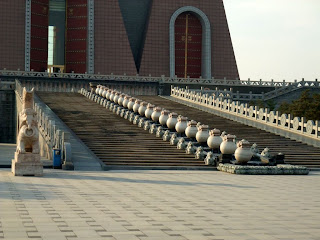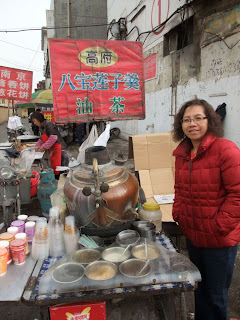
Linfen, located by the lower end of Fen River and middle reach of Yellow River at southern part of Shanxi Province, was founded 4000 years ago by Tang Yao, ruler of a tribal alliance during late primitive periods. The city that was known as Pingyang during Spring and Autumn period, was often referred as China's first capital. Prior to 1980s, it was very famous for its spring water, greenery and rich agriculture and was once nicknamed as "The Modern Fruit and Flower Town". But since then, it gradually developed into a main industrial center for the national increasing energy demand. The rapid expansion of private coal mines and heavy industries around has lead to severe environmental depredation, seriously affecting the city's air quality and farming condition. As a result, City of Linfen was listed in the ten most polluted city in the world.



To start a lessen in ancient Chinese history and culture, Linfen City is a right place.



The marching guards around Pingyang's Drum Tower in the morning of Linfen City.




The First Gate of China was a huge structure newly built at the front square of Yao Temple.


The structure of First Gate and Yao Square were built basing on some important factors relating to Yao's era.



The ornamental pillar known as Huabiao (华表) in Chinese, is erected at Yao Square. Huabiao was a well-known architectural ornament in China. Commencing from Yao Era, wooden crosses were erected at marketplaces to solicit public criticism. People used to write down their comments, complaints or wishes on these wooden posts in ancient era. In Han Dynasty, the wooden posts were replaced by stone pillars which gradually grew into more decorative and ornately carved until it became sumptuous columns to palace gates.




Wall of Chinese surnames.


Learn the Chinese surnames from here. You would be surprised to find out that there are so many unique and unusual surnames that many of us are never heard of.



Emperor Yao was known to be a virtuous, wise, intelligent and benevolent leader who always put his citizen in the first place and ensured them a happy and peaceful life. He had set a model for rulers in ancient China in later centuries. Yao Temple was built in year 1340 to honor this legendary sage and served as a site to hold memorial ceremonies for him.



Yao Temple was first built in Jin Dynasty but rebuilt and expanded in Tang, Yuan, Ming, and Qing Dynasty. The Temple Complex consists of 5 buildings and there are over 10 steles written with the achievements of Emperor Yao.



One of the main buildings in the Temple Complex is The 5-Phoenix Palace, a place where Emperor Yao handled the state affairs. It was named after the five personages who occupied it as in ancient times. Emperor Yao and the other four officials were respected as five phoenixes symbolizing the 5 sage monarchs.



Beyond the 5-Phoenix Palace stands a Well Pavilion, by which a 10 meter deep well was sheltered. The well which was said to be dug by Emperor Yao still has water that is clear and drinkable, until today.



The first dragon in China. This initial shape of dragon looks rather like a snake.




The magnificent Guangyun Hall is just behind the Well Pavilion. The Hall enshrined a huge statue of the Majestic Yao in a solemn and dignified manner for visitors to show respect. This is the main hall where people making offerings or sacrifices to Emperor Yao.




The existing Guangyun Hall was a restored structure. The original building with height of 27 meter and with 42 stone pillars carved with dragons in the corridors was destroyed in a fire.


The Drum Tower, Halls for Emperor Da-Yu (禹帝) and Emperor Sun (舜帝), the other two sage monarchs.



The beautiful sunset at Yao Temple Square.



Dayun-si Temple (Great Cloud Temple 大云寺) also known as Tiefo-si (Iron Buddha head Temple 铁佛寺)lies at south west corner of Linfen City. The site being the only complete and best preserved ancient temple complex has turned into a live museum in the city.



Basing on inscription on the Steles, the temple site was first built in year 632 but destroyed during the earthquake occurred in 1695 during the reign of Emperor Kangxi in Qing Dynasty. The present structures were restored in 1715. The Temple Complex is divided into two parts, with Main Shrine Hall, Offering Kiosks, Nave and Side Halls at front and Golden-Top Pagoda and scripture Library at the back.



The Buddha head placed in the center base of Golden-Top Tower was cast from raw iron in Tang Dynasty, 1300 years ago.




This Tang's original iron head statue of Sakyamuni Buddha measures 6.3 meter in height, by 5 meter in diameter with weight of 15 tons. The 3.8 meter wide face looks plump but dignified and vivid.



The Golden-top Pagoda standing at the site for 1300 years was destroyed during the earthquake in 18th May 1695 during Qing Dynasty but restored 20 years later in 1715.




The 6-storey Golden-Top Pagoda is the essence of the monastery. From first to 5th floor, it is square in shape but octagonal at the 6th storey.



The 35 meter high tower is a green-brick structure with Tiefeng edge at four corners. Jingling sound were heard when wind blows.





The Pagoda is adorned with beautifully decorated Buddhist legends and images.



The ancient temple site is hiding behind Linfen College and there are so many food stalls along the little pathway going towards it.



Dishes of local delicacy. The tiny little bun as small as a fish ball are the most delicious bun we ever had.


Exercising crowds are a normal morning scene at all parts of China, thus no exceptional in Linfen City.



All visitors when entering Linfen City are welcomed by pairs of huge statues of symbolic bull with buttock and tail up.




Country side.












The polluted plants in the sun-setting beam.








Leaving Linfen, we head for our next destination, Yucheng in a SUV private car. We were offered a lift by a kind Yucheng business man, who came to Linfen for business and stayed in the same hotel as us. They sent us direct to the hotel we booked in Yucheng and made sure every thing was in order before saying good-bye to us.





No comments:
Post a Comment